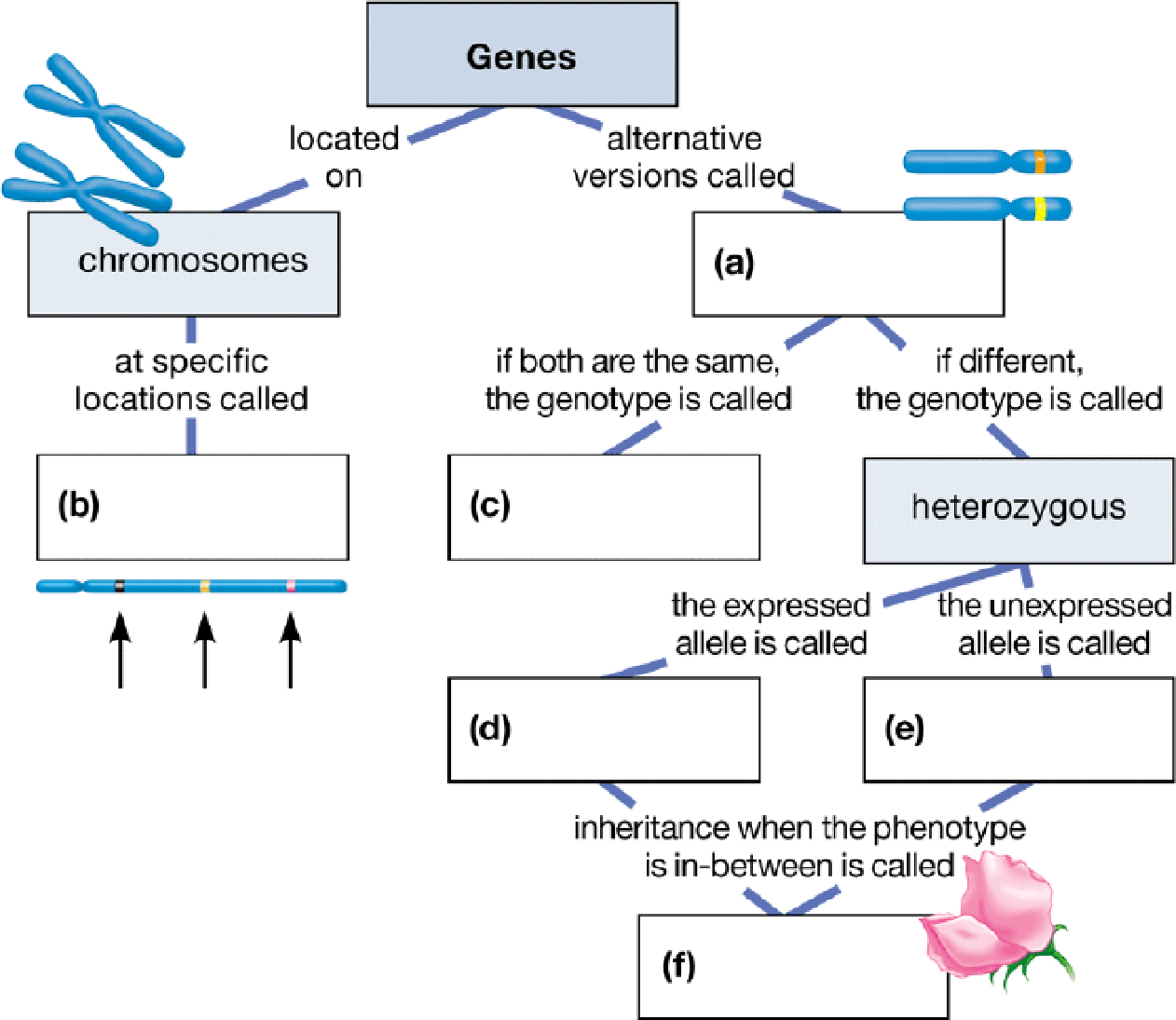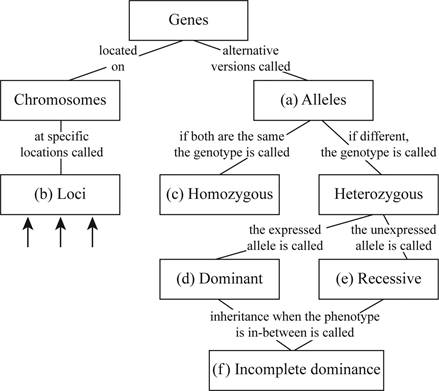
Concept explainers
Connecting the Concepts
1. Complete this concept map to help you review some key concepts of genetics.

To complete: The given map showing some key concepts of genetics.
Introduction: Genetics forms the basis of heredity. It is the study of genes, inheritance patterns, and their expression leading to various traits in living beings.
Answer to Problem 1CC
Pictorial representation: Fig. 1 shows the completed map key concepts of genetics.

Fig.1:Key concepts of genetics
Explanation of Solution
(a)
Correct answer: Alleles
Explanation: Genes have alternate forms known as alleles. The two alleles of a gene segregate into different gametes and are transmitted to offspring. Hence, the correct answer is alleles.
(b)
Correct answer: Loci
Explanation: Genes are DNA sequences that code for specific traits. The specific position of a gene on a chromosome is known as locus. The plural of locus is loci. Hence, the correct answer is loci.
(c)
Correct answer: Homozygous
Explanation: The alleles of a gene segregate into gametes and transmitted to offspring. They are dominant and recessive alleles. When the two alleles are same in an individual(either dominant or recessive), its genotype is homozygous. Hence, the correct answer is homozygous.
(d)
Correct answer: Dominant
Explanation: Dominance in alleles of a gene occurs when a phenotypic effect of one allele suppresses the phenotypic effect of a second allele. If the two alleles are different in an individual, then the dominant allele out of the two alleles expresses itself and determines the phenotype. Hence, the correct answer is dominant.
(e)
Correct answer: Recessive
Explanation: A dominant allele masks the expression of a second allele. The masked allele is known as recessive because its phenotypic effect is suppressed. Hence, the correct answer is recessive.
(f)
Correct answer: Incomplete dominance
Explanation: Dominance explains how different alleles of a gene express themselves. Some genes show incomplete dominance, which means that individuals with homozygous alleles produce offspring that is intermediate of the two parent alleles. Hence, the correct answer is incomplete dominance.
Want to see more full solutions like this?
Chapter 9 Solutions
CAMPBELL BIO: CONCEPTS&CONNECTIONS (LL)
- Briefly state the physical meaning of the electrocapillary equation (Lippman equation).arrow_forwardExplain in a small summary how: What genetic information can be obtained from a Punnet square? What genetic information cannot be determined from a Punnet square? Why might a Punnet Square be beneficial to understanding genetics/inheritance?arrow_forwardIn a small summary write down:arrow_forward
- Not part of a graded assignment, from a past midtermarrow_forwardNoggin mutation: The mouse, one of the phenotypic consequences of Noggin mutationis mispatterning of the spinal cord, in the posterior region of the mouse embryo, suchthat in the hindlimb region the more ventral fates are lost, and the dorsal Pax3 domain isexpanded. (this experiment is not in the lectures).a. Hypothesis for why: What would be your hypothesis for why the ventral fatesare lost and dorsal fates expanded? Include in your answer the words notochord,BMP, SHH and either (or both of) surface ectoderm or lateral plate mesodermarrow_forwardNot part of a graded assignment, from a past midtermarrow_forward
 Human Heredity: Principles and Issues (MindTap Co...BiologyISBN:9781305251052Author:Michael CummingsPublisher:Cengage Learning
Human Heredity: Principles and Issues (MindTap Co...BiologyISBN:9781305251052Author:Michael CummingsPublisher:Cengage Learning Biology: The Unity and Diversity of Life (MindTap...BiologyISBN:9781337408332Author:Cecie Starr, Ralph Taggart, Christine Evers, Lisa StarrPublisher:Cengage Learning
Biology: The Unity and Diversity of Life (MindTap...BiologyISBN:9781337408332Author:Cecie Starr, Ralph Taggart, Christine Evers, Lisa StarrPublisher:Cengage Learning Biology (MindTap Course List)BiologyISBN:9781337392938Author:Eldra Solomon, Charles Martin, Diana W. Martin, Linda R. BergPublisher:Cengage Learning
Biology (MindTap Course List)BiologyISBN:9781337392938Author:Eldra Solomon, Charles Martin, Diana W. Martin, Linda R. BergPublisher:Cengage Learning Biology Today and Tomorrow without Physiology (Mi...BiologyISBN:9781305117396Author:Cecie Starr, Christine Evers, Lisa StarrPublisher:Cengage Learning
Biology Today and Tomorrow without Physiology (Mi...BiologyISBN:9781305117396Author:Cecie Starr, Christine Evers, Lisa StarrPublisher:Cengage Learning





